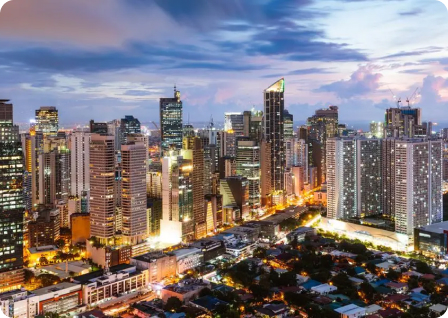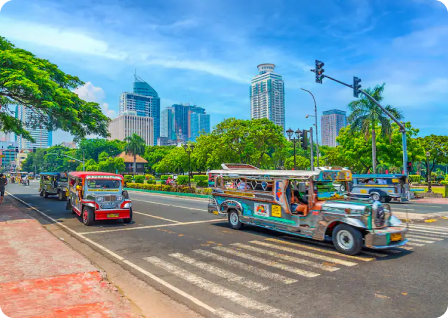


MBBS in Philippines is becoming a good choice for Indian Students to Study MBBS Abroad. It has one of the best education systems in the continent. Students have an opportunity to pursue medical education in English language, it is the largest English speaking country in the region. Philippines Medical Colleges offer low-budget and high-quality medical education to International students.
MCI/NMC Approved Medical Colleges in the Philippines offer quality education to foreign country students, and highly qualified faculty are available to provide the best clinical knowledge to students. The top medical colleges in the Philippines offer a Doctors of Medicine Program or MD degree which is equivalent to MBBS and also offer better exposure to mbbs in philippines for Indian students.
| Detalis | Attributes |
|---|---|
| Degree Awarded | MD Equivalent to MBBS in India |
| Approved by | MCI/NMC & WHO |
| Popular Course | MBBS |
| MBBS in Philippines Duration | 6 Years |
| Medium of Education | English |
| MBBS in Philippines Eligibility | 50% Marks in PCB |
| Entrance Exam | NEET EXAM |
| MBBS in Philippines Fee | 14.80 lakh Minimum |
| Country Type | Republic |
| Officially Known as | Republic of Philippines |
| Capital | Manila (de jure) |
| Largest City | Quezon City |
| Area | 3000,000 km2 |
| Religion | Christianity, Roman Catholic, Islam |
| Population | 11.73 crores |
| Currency | Philippine peso |
Philippines, officially known as Republic of Philippines is a beautiful country in Southeast Asia, it has around 109 million population and covers an area of 300,000 km2. It is a multinational country with diverse cultures, Manila is the capital of the country which is one of the beautiful countries here. The country offers better opportunities for applicants who wish to study MBBS in the Philippines. Applicants need to qualify the NMAT Exam, which is designed to select the students who are looking for MBBS/MD Admission in the Philippines.
The following organizations recognize the universities of the Philippines:

Students need to meet the MBBS in Philippines Eligibility Criteria if they want to apply for admission at MCI/NMC Approved Medical Universities in the Philippines. They just need to clear the NEET Exam as it is mandatory for Indian students to get MBBS Admission in the Philippines.
| Entrance Exam | NEET Qualified is compulsory |
| Academics |
|
| Age | The minimum age required is 17 or students who complete 17 till 31st December of the admission year can also apply. |
Plans to Study MBBS Abroad then MBBS in Philippines could be a good option for Indian Students. Detailed information about the admission process is needed to know before applying for admission students must follow easy steps given below:
When applying for MBBS in the Philippines, students must ensure they have the required documents to complete their admission process. These documents are crucial for both application and visa procedures. Below is a list of essential documents that every student must provide when seeking admission to study MBBS in the Philippines:
The universities in the Philippines have an MBBS program for foreign aspirants which is also known as the MD program. This is equivalent to MBBS in India, it will take a total of 6 years of time duration. The medical courses offered in the Philippines are available in the English language.
Moreover, MBBS courses are famous in Philippines universities but there are universities that offer some specializations in medical courses. We have mentioned it here.
The duration of mbbs in philippines is 6 years including 1 year internship program. The MD (MBBS) course is 4.5 years(54 months). The Philippines universities save 6 months of students.
| Course | Duration |
|---|---|
| MD Program/ MBBS | 6 years |
| Dentistry Program | 5 Years |
| Bachelors in Pharmacy | 4 |
| Bachelors in Nursing | 4 |
All MCI/NMC Recognized Medical Universities in the Philippines have introduced the fee structure of the medical program for International candidates. Philippines mbbs fees for Indian students are low as compared to other global universities, students can check below the detailed MBBS in Philippines Fee Structure of all the institutes available for applicants in the country.
| Universities | Total Tuition Fee (Pesos) | Total Tuition Fee (INR) |
|---|---|---|
| AMA Medical College of Medicine | 12,50,000/- | 16,25,000/- |
| Davao Medical School Foundation | 13,53,783/- | 20,50,000/- |
| Bicol Christian College of Medicine | 14,76,187/- | 22,34,485/- |
| Emilio Aguinaldo College | 15,55,000/- | 23,83,000/- |
| Lyceum Northwestern University | 12,50,000/- | 16,25,000/- |
| University of Perpetual Help System DALTA | 13,50,000/- | 20,44,270/- |
| UV Gullas College of Medicine | 11,10,000/- | 14,80,000/- |
| Our Lady Fatima University | 18,38,060/- | 28,14,844/- |
The charges for an MBBS degree in the Philippines are 15-22 lakh for five years. Medical degrees given by MBBS colleges are confirmed and approved by WHO, NMC and other authoritative organizations.The achievement rate of USMLE guarantees the quality of schooling, which is 100% here.All the universities in the country have their tuition fees or in simple words, tuition fees may vary from college to college. Some of the highly ranked and top mbbs colleges in philippines for MBBS courses in the Philippines are listed below:
Check out here are some best mbbs college in philippines listed below
| Details | Information |
|---|---|
| University Name | University of Perpetual Help System DALTA |
| Founded in | 1975 |
| Type | Private |
| Location | Manila, Philippines |
| Ranking | 27th (in Philippines) by 4ICU |
Offer an affordable MBBS program for international candidates.Standard education system. Approved by NMC & WHO.
| Details | Information |
|---|---|
| University Name | AMA School of Medicine |
| Founded in | 2008 |
| Type | Private |
| Location | Makati, Philippines |
World-class infrastructure Hospital for clinical practice.1st medical colleges in Mindanao
| Details | Information |
|---|---|
| University Name | Davao Medical School Foundation |
| Founded in | 1976 |
| Type | Private |
| Location | Mindanao, Philippines |
| Ranking | 158th (in Philippines) by Webometrics |
Popular medical university in the Philippines. Highly educated doctors. Globally accepted MBBS degree.
| Details | Information |
|---|---|
| University Name | Bicol Christian College of Medicine |
| Founded in | 1980 |
| Type | Private |
| Location | Legazpi, Philippines |
| Ranking | 36th (in Philippines) by 4ICU |
| Details | Information |
|---|---|
| University Name | Emilio Aguinaldo College |
| Founded in | 1957 |
| Type | Private |
| Location | Manila, Philippines |
| Ranking | 53rd (in Philippines) by 4ICU |
| Details | Information |
|---|---|
| University Name | Our Lady Fatima University |
| Founded in | 1973 |
| Type | Private |
| Location | Valenzuela, Philippines |
| Ranking | 10th (in Philippines) by 4ICU |
Indian students who apply for admission to Philippines Medical Colleges get hostel facilities at an affordable cost. Applicants get all the facilities with accommodation into the hostel, universities also take care of student’s security so they arrange better security in the hostel.
Top 6 MBBS Universities for Indian Students
| MBBS in Russia | MBBS in Georgia |
| MBBS in Kyrgyzstan | MBBS in Kazakhstan |
| MBBS in Uzbekistan | MBBS in Bangladesh |
| MBBS in Nepal | MBBS in Uzbekistan |
Q1. Is the Philippines the safest country for Indian students?
Yes, the Philippines is one of the safest countries for Indian as well as foreign students, it has proper security arrangements at universities as well as in the hostel. Medical Universities in the Philippines have an Indian community which ensures that it is safest to study in the Philippines.
Q2. Are many Indian applicants available in the Philippines?
Every year thousands of international students apply to study MBBS in the Philippines among which hundreds of students are Indian. The strength of Indian students in the universities is huge.
Q3. What are the MBBS Fees in the Philippines for Indian students?
All MCI/NMC Approved Medical Colleges in the Philippines offer a low-cost medical program. So 20 lakh is the average MBBS fee in the Philippines for Indian students.
Q4. Is an MBBS Degree from the Philippines valid in India?
Yes, an MBBS degree from the Philippines is valid in India as well as in other foreign countries. As the medical universities in the country are recognized by NMC and WHO, degrees awarded by the universities are also accepted anywhere in the world.
Q5. Do Universities in the Philippines offer an English language program for Indian candidates?
Yes, all Top Medical Universities in the Philippines provide medical education in the English language to all international candidates.